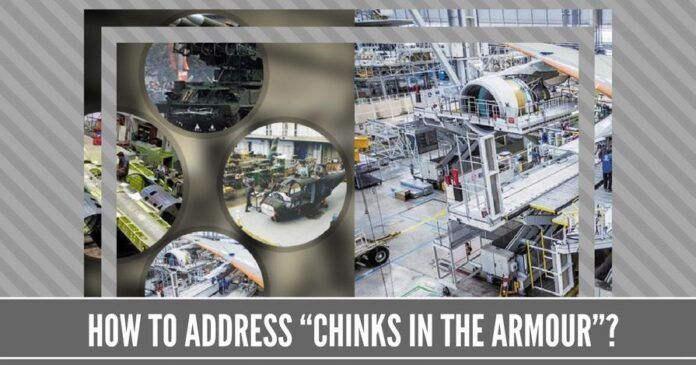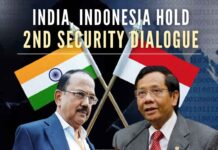
India’s self-reliance in defence manufacturing, one constituent in the national security paradigm rests on three pillars: the political leadership, the bureaucracy and the Armed Forces
In his ‘op ed’ published in the Chennai edition of Sunday 10 June of The Hindu, Happy Mon Jacob waxes eloquent about the articles in the newly released “Oxford Handbook of India’s National Security” going so far as averring that ‘he has not come across a comparable book on India’s national security with the same intellectual rigour, range and insightfulness’.
The industries we visited were not only of world-class capability but were thirsting to enter into the defence manufacturing space
Not possessing any of these qualities myself, but having served in the Indian Armed Forces for three decades (including being dived off the shores of Karachi on board a submarine during the Indo-Pak conflict of 1971), and then spending another three decades on the fringes of matters military, I am constrained to point out many chinks in the analysis made by him!
The one point I cannot argue about is the subtext to the article that reads “Scholars point to gaping holes in India’s national security architecture and call for political attention to structural reforms”.
I was at a social evening yesterday, to facilitate some of those from the MSME sector in Chennai who had done yeomen work in ensuring the successful participation of many of its members in the recently concluded DEFEXPO 2018 in Chennai.
Some of them were grizzled veterans (not of the Indian Armed Forces – in fact, I was the only Ex-Serviceman present) from the defence manufacturing industry. Others were young wannabes who had tasted success in the Automobile sector and wanted to venture out into the much-touted Defence Industrial Corridor of Tamil Nadu, one of the two announced with great fanfare by the Hon’ble Finance Minister in his budget speech in March 2018. We will revert to their experiences shortly.
In one of his opening paragraphs, Happy Mon, asks the basic question, “What after all is national security?” and then goes on to quote ‘three well-regarded editors” of the Oxford Handbook on this question, followed by a lengthy explanation of their views.
I would put it in much simpler terms. Security, national, or personal has both mental and physical connotations. It is first a feeling that what I or the nation have/has, cannot be taken away. This is inseparable from the conviction that what I or the nation have/has, can grow and develop in an unfettered manner, given the compulsions of contemporary technology, economy and many other relevant factors. If either the feeling or conviction is impaired, “security” is threatened.
As argued in an earlier article of mine, the lay public cannot distinguish between security and defence on the one hand, and between, defence and military on the other. A 50,000 feet analysis of these two issues by our scholars and defence analysts does not help in allaying this lacuna either, especially with respect to matters military, in general, and the wherewithal to support the military, in particular.
Happy Mon cites several important points made by the authors of the book. These include views on India’s Defence Industrial base, Civil-Military relations, and the need to modernize, not only capabilities and procedures but also institutions. These are all valid observations, but regrettably, no clues have been offered on how to rectify the perceived shortcomings. Let us take a deeper look at these three issues to start with.
There is definitely something wrong with our Defence Industrial base if even after seven decades of Independence, we still import 70% of our military hardware. The problem is not with the competence and capabilities of our industry.
I had the opportunity, recently to accompany a high ranking team of Naval officers to half a dozen small industrial complexes in Tiruchirapalli, a Tier 2 city, in Tamil Nadu known for its heavy engineering capability (thanks to the location of Bharat Heavy Electricals boiler plant), and academic excellence (thanks recently to the location of the National Institute of Technology, and of decades earlier of institutions such as St Joseph’s College, the alma mater of Bharat Ratna Abdul Kalam).
The industries we visited were not only of world-class capability but were thirsting to enter into the defence manufacturing space. In fact, in my opinion, as a former Joint Director Submarine Acquisition at Naval Headquarters, with modern transportation facilities available, Tiruchy, in spite of no access to the coastline, could well develop into a ship/submarine building hub!
The bureaucracy in the Ministry of Defence is transitory. So it is left to the Political leadership of vision and will to make structural changes in our security set up.
Why then has it not happened? Let us go back to one of the grizzled defence manufacturing veterans who attended yesterday’s social get together. What he had to say of the “procurement system” could fill a book, and perhaps be a subject of another review of Happy Mon Jacob.
According to him, no amount of tinkering with policies and procedures at South Block, where the Department of Defence production is located, can alter things on the ground, unless inspection procedures were streamlined, and shop floor inspectors from the myriad inspection agencies, held accountable for delays which resulted in “chinks in the armour” in Siachen or other theatres of war, and consequently on dependence on imports to manage obsolescence of our inventory, especially of ‘Soviet origin, and their attendant heavy costs and inordinate delays.
Another point which emerged, both during my interactions with the Naval team and with the grizzled defence manufacturing veteran, was the lack of continuity in office of those dealing with defence acquisition and manufacturing, both amongst uniformed personnel at Services Headquarters and at decision making echelons at the Ministry of Defence.
Let us move to the next vexed and vital question of Civil-Military relations. As the old adage goes, ‘there is nothing new under the sun’. The report of the “Kargil Committee” chaired by the eminent defence analyst, Mr K. Subrahmanyam is a classic vindication of this truism.
Much of what is perhaps contained in the “Oxford Handbook of India’s National Security” so eloquently reviewed by Happy Mon Jacob in 2018, is contained in this critical analysis of the ‘chinks in our armour” made more than two decades ago.
Amongst the important recommendations made in the Kargil committee report was that of the need for integrating the Armed Forces within the ‘Government mechanism’, unified (or theatre) commands, establishment of a Chief of Defence Staff, and a comprehensive defence procurement policy. Why have we not been able to achieve anything of substance in any of these areas?
And finally, on the need for modernization of institutions. We definitely need a Mr Bitzinger to remind us of this, since it is elaborately discussed in Mr Subrahmanyam’s report, and like in many other areas, we have done nothing about it.
In my humble opinion, in India’s self-reliance in defence manufacturing, one constituent in the national security paradigm rests on three pillars: the political leadership, the bureaucracy and the Armed Forces. The last named is not involved or associated in the decision-making process. The bureaucracy in the Ministry of Defence is transitory. So it is left to the Political leadership of vision and will to make structural changes in our security set up. Perhaps the time is ripe to bite the bullet.
Let me end with quoting the concluding paragraph of the epilogue of the Kargil committee report:
Quote
There is both comfort and danger in clinging to any long-established status quo. There will be many who suggest the most careful deliberation on the report. Procrastination has cost nations dear. Others will no doubt advocate monumental change. Half measures will not do; synergy will be lost. The Committee has after very wide interaction sign-posted directions along the path to peace, ensuring progress, development and stability of the nation. How exactly the country should proceed to refashion its Security- Intelligence-Development shield to meet the challenge of the 21st Century is for the Government, Parliament, and public opinion to determine. There is no turning away from that responsibility.
Unquote











More interesting read at..
https://www.oneindia.com/feature/in-between-isro-and-drdo-where-lies-the-difference-1529652.html#infinite-scroll-1